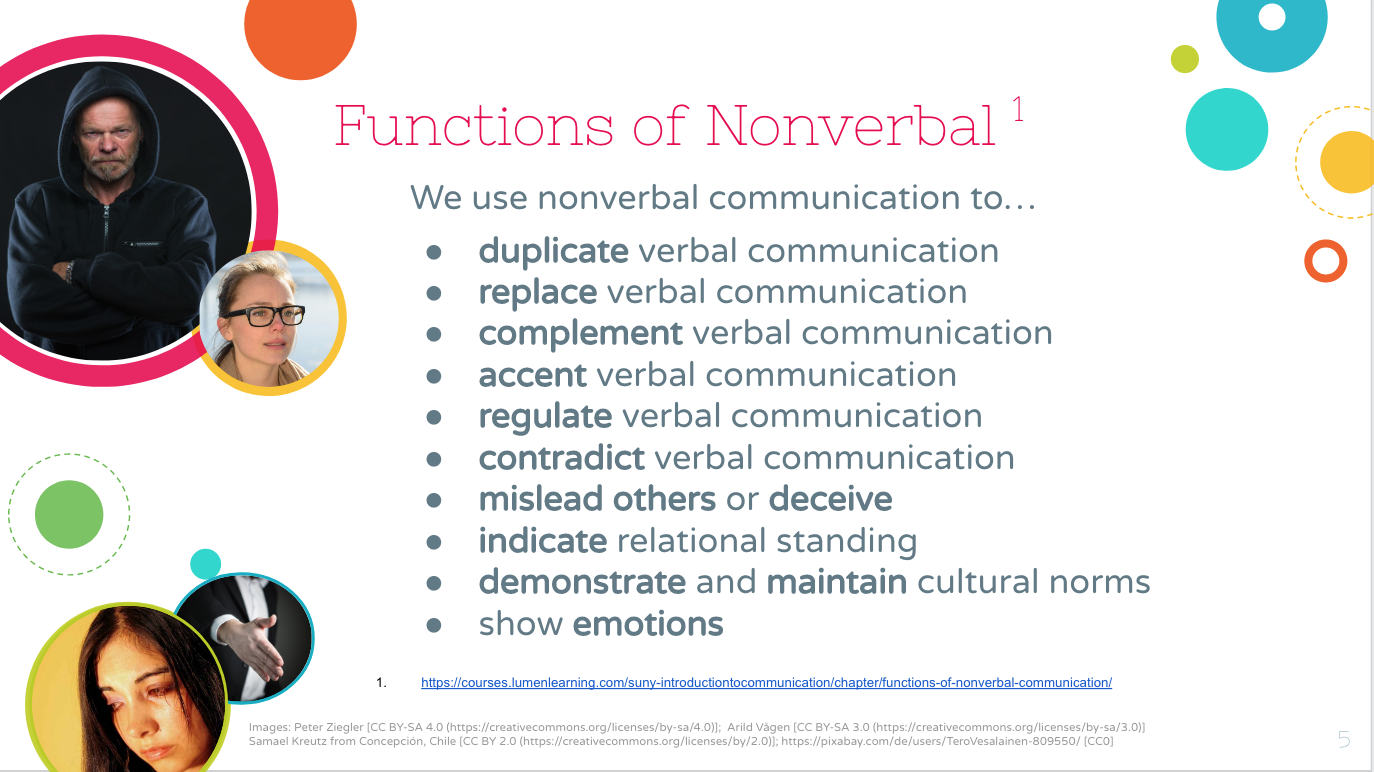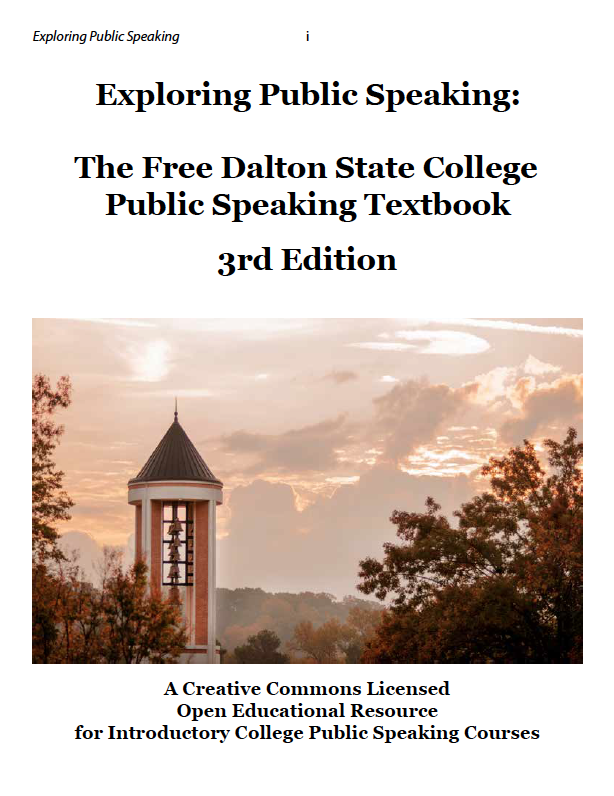Nonverbal Communication Resources

Overview
Scholars and practitioners agree that between 50-65% of the information that we communicate with others is done through nonverbal channels... That is, all of the ways that we communicate without using words. Whether it’s a smile or a smirk; eye contact and a nod; gestures, or touch...they all send a message. This section introduces students to the ways in which nonverbal communication is used at an interpersonal level as well as in the public speaking context. As public speakers, students will learn to use nonverbal communication to develop rapport with their audience, to demonstrate confidence and competence, and to deliver clear, engaging, and memorable speeches. Developing strong nonverbal communication habits takes practice, and this chapter includes educational activities designed to help students hone their skills. When used effectively, nonverbal communication can support the words that are being said and improve the effectiveness of the message. When used poorly, nonverbal cues can confuse the audience, or worse, may send the message that the speaker is unprepared, uninterested, or even deceitful. This section provides information that will help students understand the best ways to use nonverbal techniques to become a more confident and engaging presenter.
Learning Objectives
Upon completion of this topic, students should be able to:
- Articulate the principles of nonverbal communication
- Distinguish types of nonverbal communication: kinesics, haptics, proxemics, chronemics, paraverbal/paralinguistic/vocalics
- Understand and interpret various uses of nonverbal communication
- Apply effective nonverbal communication to the public speaking context
Recommended Textbook Resources
Stand up, Speak out: The Practice and Ethics of Public Speaking

Exploring Public Speaking: 3rd Edition (2018). Communication Open Textbooks
This textbook is available in multiple formats from the publisher’s website. Click the link to access various options including downloading a PDF, ePub & Kindle formats, or individual chapter downloads. Links to individual chapters online are not currently available.
- Section 11.5 What to Do When Delivering Your Speech
These chapters address many important aspects of nonverbal communication. While the chapters are not devoted exclusively to nonverbal, they offer information that’s pertinent to nonverbal in the public speaking context. In this way, the material aligns closely with the OCM/SLO for this section. The material was selected by the team for its comprehensive topic coverage; clear, engaging language, thorough supporting sources from some of the leading scholars in the field; and of course, the publisher’s commitment to open educational resources.
Stand up, Speak out: The Practice and Ethics of Public Speaking

Exploring Public Speaking: 3rd Edition (2018). Communication Open Textbooks
This textbook is available in multiple formats from the publisher’s website. Click the link to access various options including downloading a PDF, ePub & Kindle formats, or individual chapter downloads. Links to individual chapters online are not currently available.
- Section 11.5 What to Do When Delivering Your Speech
These chapters address many important aspects of nonverbal communication. While the chapters are not devoted exclusively to nonverbal, they offer information that’s pertinent to nonverbal in the public speaking context. In this way, the material aligns closely with the OCM/SLO for this section. The material was selected by the team for its comprehensive topic coverage; clear, engaging language, thorough supporting sources from some of the leading scholars in the field; and of course, the publisher’s commitment to open educational resources.
Supplemental Content/Alternative Resources
Articles
- The Power of Mindful Nonverbal Communication - Beheshti, N. (2018, September 20). Forbes.
- 5 Nonverbal Communication Cues All Great Speakers Have Mastered - Benna, S. (2015, July 23). Business Insider.
- Negative Body Language: 7 Deadly Sins of Nonverbal Communication - Genard, G. (2017, April 9).
Retrieved from
Cultural Differences in Nonverbal Communication
- Why Americans Smile So Much: How immigration and cultural values affect what people do with their faces - Khazan, O. (2017, May 3). The Atlantic.
- How Culture Controls Communication - Goman, C. K. (2011, November 28). Forbes.
- Body Language for Global Business - Goman, C.K. (2011, December 6). Forbes.
Video Resources
- Body Language: The Key to Your Subconscious - Ann Washburn
- Gestures and Body Language - Toastmasters International
- Former FBI Agent Explains How to Read Body Language - Tradecraft | WIRED
- Explaining Nonverbal Communications with Clips from “Friends”
PowerPoint Slides

Topic Application Section
As noted above, a significant portion of what we communicate is done through nonverbal channels. Because nonverbal communication is so important at the interpersonal level, and in the public speaking context, students should be encouraged to observe, critique, and practice nonverbal communication as much as possible during a term. The following topic application activities can be used to meet this goal.
*It is important for instructors to be aware that not all students may be able or willing to participate in activities involving certain physical movement. Instructors should not exclude these students, but rather, invite everyone to participate in a way that is comfortable and suitable to their individual needs.
Charades
A game of Charades is a fun and engaging way for students to practice communicating nonverbally. Students can be split into 2 or 3 teams (depending on class size). One member from the team stands at the front of the room and acts out a clue for their teammates to guess. Clues should be simple words or phrases that can acted out easily in one minute. The acting student cannot use words or sign language, and may not write or draw anything. If the team successfully guesses the clue within one minute, they get a point. If not, the other team(s) gets one guess to “steal” the clue. If the opposing team guesses correctly, they get a point, but if not, no points are awarded. After the first team has completed their turn, the next team sends a representative to the front to act out another clue. Teams alternate in this way until the end of the game. Instructors can end the game after a) everyone has acted out a clue, b) one team reaches X number of points, or c) a pre-set amount of time.
Clues can be taken from a number of sources:
- Have all students write down 2-3 clues on small pieces of paper from the following categories: nouns, verbs, action phrases, popular songs/movies/books, celebrities/famous people, or idioms. All the clues are then shuffled and placed in a box/bag/hat from which the actor chooses.
- The instructor could make use of clue cards from popular board games such as Pictionary or Taboo (if they are available)
- There are several free mobile phone apps available that can be used for this
- Online clue generators:
- http://www.getcharadesideas.com/
- https://www.thegamegal.com/word-generator/
- https://www.wordgenerator.net/charades-generator.php
After the game, a short debrief can be used to help students recognize how they used different nonverbal techniques to communicate the clue. Discuss challenges or frustrations that students experienced.
--
Nonverbal Analysis / Application Worksheet
The worksheet document can be accessed by clicking on the link to the right. (Download a PDF)
This assignment should be completed by a pair of students working together. Students take turns embodying the emotion or action in the first column and then discussing how the action felt (as the actor) and how it was received (as the observer). Students can use this sheet to make notes or write down their reactions to the activity. As a debriefing activity, answers may be compared/discussed with the larger class group after completion of the activity. Instructors should allow ample time for this activity and provide a facilitated all-class debriefing afterward.
Prior to the activity, instructors should provide some examples of what students should pay attention to, or how they might articulate what they’re experiencing. For example, as they embody stressful or frustrating situations, they might experience a sensation of heat in their cheeks or ears, or a tightness in their muscles. In contrast, joyous or pleasurable actions might elicit laughing, deep exhaling (relief), or a sense of relaxation in the muscles.
Finally, have students make note of how they (as both actor and observer) are physically engaging with the prompt...are they moving their hands a lot? What does posture look like? What facial expressions are used? If the prompt involves speaking, what paraverbal cues are employed?
End of Section Review
Nonverbal communication, in all its forms, is a critical part of the communicative process. Whether in an interpersonal situation or a public speaking context, nonverbal cues send important messages about our relationship with the listener, our intent as a speaker, our moods, our social status, and even our level of preparation. This section has reviewed the principles of nonverbal communication, including the purposes of nonverbal in relation to verbal.
The five major types of nonverbal communication were reviewed, and students should now have an understanding of kinesics (movement), proxemics (distance), haptics (touch), chronemics (time), and paralinguistics (tone, pace, rhythm). Also in this section, students learned the importance of being aware of, and in control of their nonverbal communication in the public speaking setting. As a speaker, nonverbal can be used to demonstrate competence and confidence, to build rapport with the audience, and to create an interesting, engaging presentation! Because so much of what we communicate is done nonverbally, it is important that speakers are able to use their bodies, voices, eyes, and hands effectively in personal, professional, and social settings.
Key Terms
- chronemics
- haptics
- kinesics
- proxemics
- Intimate space / personal space / social space / public space
- chronemics
- monochronic
- polychronic
- paraverbal / paralinguistic / vocalics
- rate of speech
- vocalized pauses
- dynamics
- monotone
- tone/pitch
- prosody
- vocal variety
- diction
- enunciation
- pronunciation
- inflection
Review Questions
- What are the functions of nonverbal communication?
- Provide a short definition for each of the following:
- Kinesics
- Haptics
- Proxemics
- Chronemics
- Paralinguistic
- Identify 3-5 types of paralinguistic / paraverbal cues.
- Identify 3-5 ways that touch is used to communicate.
- What are the four zones associated with “individual space”?
- What is the difference between monochronic and polychronic philosophies?
- Why do we try to avoid “um,” “ah,” “like,” “y’know,” “m’kay,” and other vocalized pauses in public speaking situations?
- What sorts of information can be communicated through your physical appearance?
- Identify 3-5 strategies for employing effective nonverbal during a speech.
- What are some nonverbal behaviors to avoid in the public speaking context?
Critical Thinking and Discussion Questions
- Identify a time when you noticed a mismatch between someone’s verbal and nonverbal cues... how did you interpret this and how did it affect your interaction?
- Identify a time when you as the listener have judged a speaker based on their appearance. Were you right or wrong in your first assessment? Explain.
- Compare and contrast how nonverbal is used in interpersonal settings and public speaking contexts.
- Thinking about proxemics, and the four zones, identify who (or what) is allowed in each zone for you personally. Would the answers be different for someone else? Why?
- Discuss how nonverbal communication can be used positively and negatively. E.g., to build trust or to deceive. Describe what each looks like physically.
- Would you describe yourself as having a monochronic or polychronic orientation? Provide 2-3 examples from your life to support your assertion.
- Identify 2-3 examples of how differing time orientations affect aspects of life such as business and professional interactions, social settings, or even romantic relationships.
- Identify a time when you have encountered a speaker who used a lot of vocalized pauses (um, ah, y’know, m’kay, like). How did this impact their speaking, and how did you react to what you were hearing. Why?
- Recall a notable or memorable presenter you’ve seen. How did they use nonverbals to duplicate, complement, or accent their verbal communication? Try to use vivid descriptive language to explain their nonverbal cues.
- Describe a few ways that you can improve your nonverbal communication as a public speaker.
